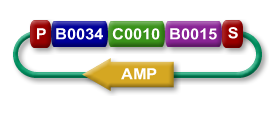Difference between revisions of "An Introduction to BioBricks"
Jamesbrown (Talk | contribs) (→Building BioBrick Systems) |
Jamesbrown (Talk | contribs) (→At the bench) |
||
| Line 25: | Line 25: | ||
==How do I make a BioBrick?== | ==How do I make a BioBrick?== | ||
| − | |||
| − | |||
| − | |||
| − | |||
| − | |||
| − | |||
| − | |||
| − | |||
====Adding the part to the registry==== | ====Adding the part to the registry==== | ||
This protocol is quick and easy. A comprehensive guide can be found [[Basic Biobrick, example 1|here]] | This protocol is quick and easy. A comprehensive guide can be found [[Basic Biobrick, example 1|here]] | ||
Revision as of 19:55, 13 July 2006

|
BioBricks are a set of interchangable parts, designed with a view to building biological systems in living cells. The picture to the left shows BioBrick part BBa_0034 within a plasmid. The yellow arrow represents the plasmid's antibiotic resistance gene and the green arrow, its origin of replication. For more information see: |
Building BioBrick Systems

|
BioBrick parts can be assembled to form useful devices, through a process often refeed to as 'Standard Assembly' This uses normal cloning techniques based on restriction enzymes, purification, ligation, and transformation. BioBrick parts are composable; allowing endless numbers of biobricks to be pieced together to form higher systems. The assembly to the left shows 3 BioBricks assembled to create a simple device. You can learn more about this device by following the link to its associated page in the registry. You may like look into:
|
How do I make a BioBrick?
Adding the part to the registry
This protocol is quick and easy. A comprehensive guide can be found here
